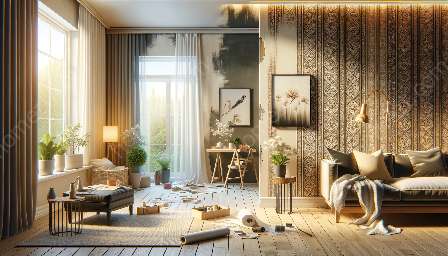Walls are an essential element of any living space, and keeping them well-maintained is crucial for creating an inviting and visually appealing home. When walls get damaged, whether it's due to wear and tear, water damage, or other factors, it's important to address the issues promptly to prevent further deterioration. In this comprehensive guide, we'll explore a variety of techniques for repairing damaged walls and seamlessly transitioning to wall painting and wallpapering to enhance your home's interior décor.
Identifying Wall Damage
Before diving into repair techniques, it's important to identify the types of damage that commonly affect walls:
- Cracks: These can be caused by structural settling, temperature changes, or poor installation.
- Holes: Often the result of accidental impacts or removal of fixtures.
- Water Damage: Water stains, mold, and mildew can indicate water leaks, which need to be addressed to prevent further damage.
Repair Techniques
Crack Repair
For small cracks, a simple joint compound or spackling paste can be used to fill the gaps. After filling and smoothing, sand the area to create a seamless finish. For larger cracks, repair tape or mesh can be used to provide a stable base for the joint compound. It's important to ensure that the underlying cause of the cracks, such as structural issues, has been addressed to prevent recurring damage.
Hole Patching
Small holes can be patched using a wall repair patch kit, which typically includes a self-adhesive patch, joint compound, and a putty knife. For larger holes, cutting out a squared, uniform shape around the damaged area can provide a strong foundation for a new piece of drywall to be installed and secured in place. The patch is then finished with joint compound, sanded, and painted to blend with the surrounding wall.
Water Damage Restoration
Dealing with water damaged walls involves not only repairing the visible stains and marks but also addressing the underlying moisture issues. After ensuring that the source of the water damage is fixed, affected drywall can be cut out and replaced. It's important to thoroughly dry the area before patching and repainting to prevent mold growth.
Preparation for Wall Painting and Wallpapering
Once the wall damage has been repaired, it's time to prepare the surface for painting or wallpapering:
- Priming: Applying a primer helps seal the repaired areas and creates a smooth, uniform base for paint or wallpaper.
- Sanding: Lightly sanding the patched areas ensures they are flush with the surrounding wall, providing a seamless finish.
- Cleanliness: Removing dust and debris from the walls is essential for optimal paint or wallpaper adhesion.
Wall Painting and Wallpapering
After the repair and preparation work, you're ready to transform your walls with fresh paint or stylish wallpaper:
Wall Painting
Choosing the right paint color and finish can significantly impact the overall look and feel of a room. Consider using light, neutral colors to create an open and airy atmosphere. Applying multiple coats of paint with even brush strokes ensures a professional-looking finish.
Wallpapering
Wallpaper offers a versatile and creative way to add texture, patterns, and character to a room. There are various types of wallpaper, including traditional paper, vinyl, and non-woven options, each with its own installation techniques. Careful measurement and cutting, along with proper adhesive application, are key to achieving a smooth and seamless wallpaper installation.
Homemaking & Interior Décor
The condition and appearance of your walls can significantly impact the overall aesthetic and ambiance of your home. By mastering wall repair, painting, and wallpapering techniques, you can take your homemaking and interior décor to the next level. Whether you prefer a minimalist, Scandinavian-inspired look or a bold, eclectic style, the condition of your walls serves as a canvas for your creative vision.
In conclusion, maintaining well-kept walls is essential for creating a welcoming and visually appealing home environment. By recognizing and addressing various types of wall damage and mastering the techniques for repair, painting, and wallpapering, you can transform your living space into a personalized and aesthetically pleasing haven.


